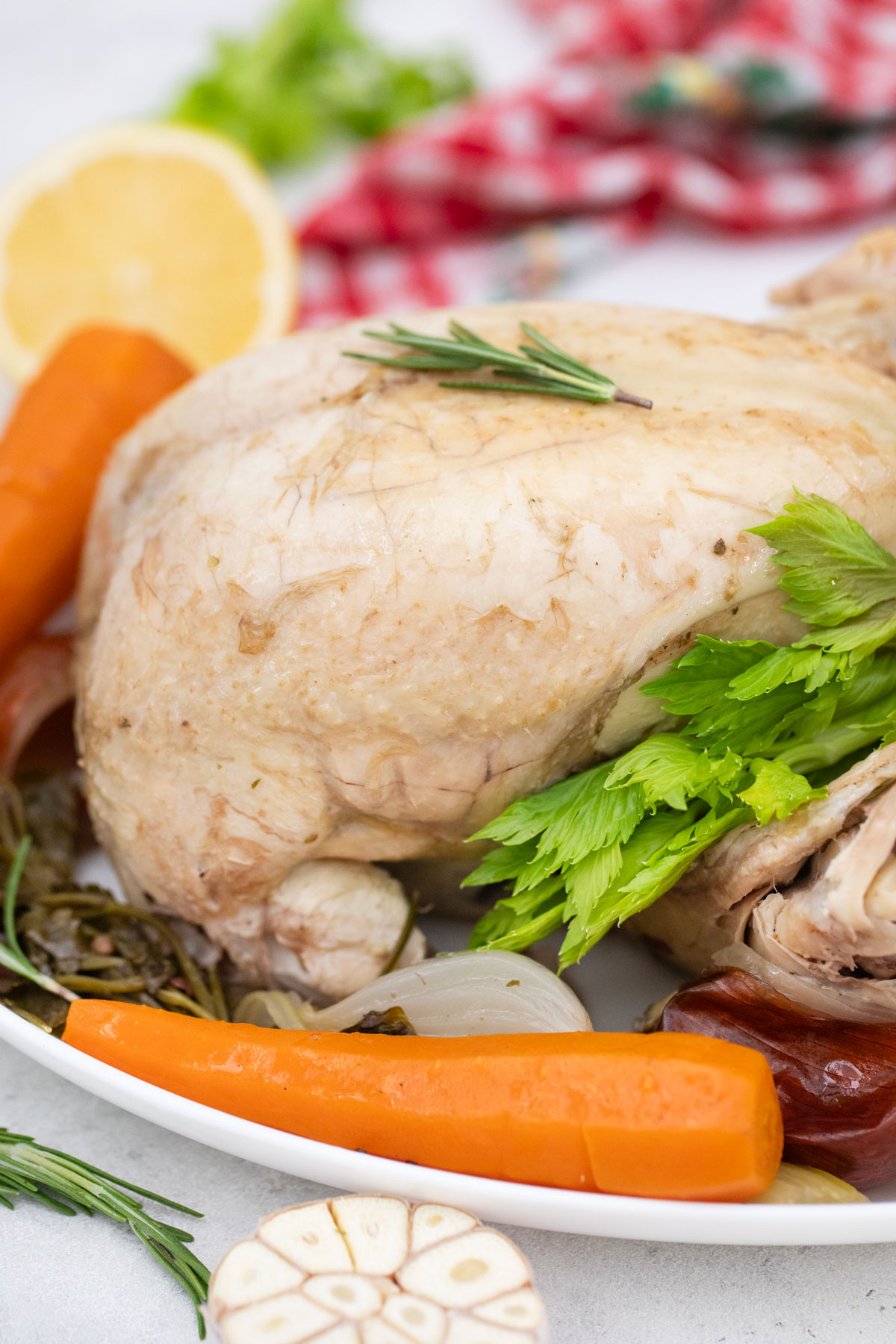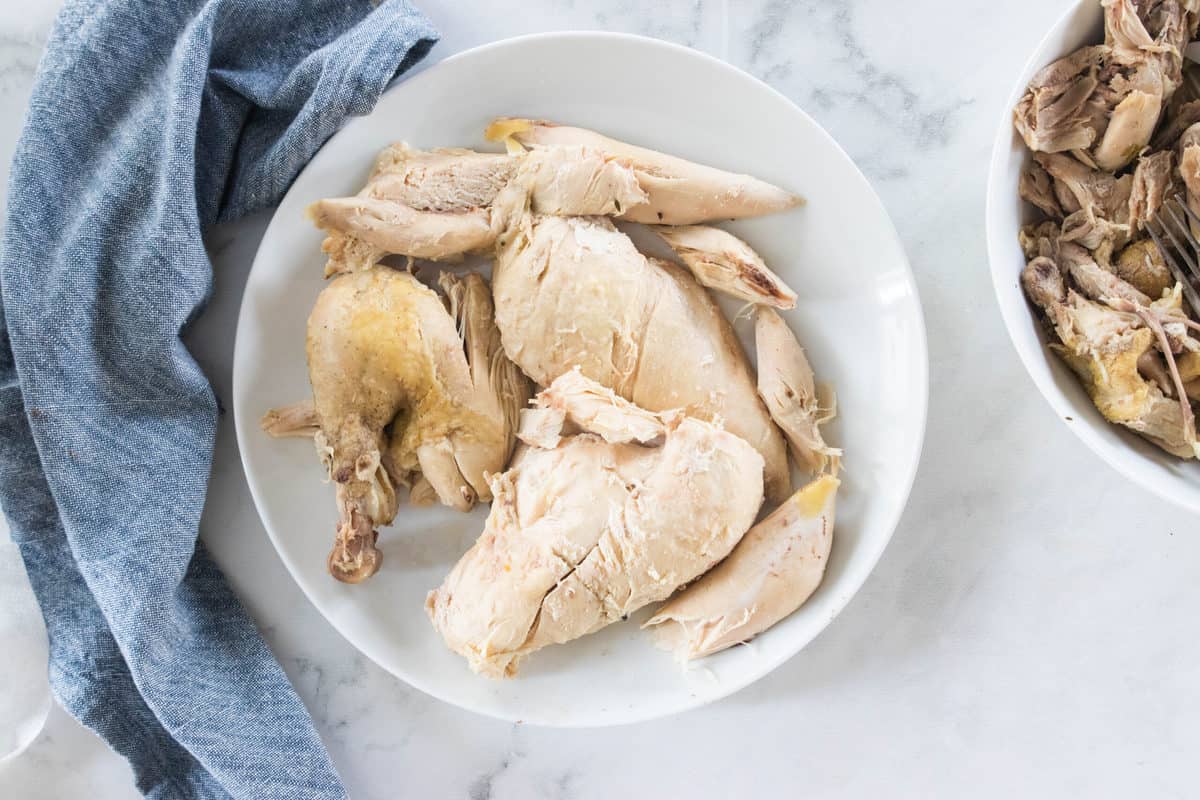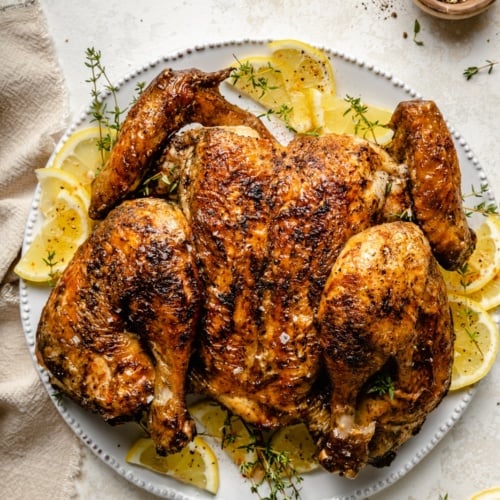
Introduction
Boiling a whole chicken is a simple and versatile cooking method that can result in juicy, tender meat. It also allows you to create flavorful chicken broth that can be used in a variety of dishes. Whether you’re looking for an easy weeknight dinner or want to impress your friends and family with your cooking skills, boiling a whole chicken is a great option.
Why Boiling Whole Chicken Is A Great Cooking Method
Boiling a whole chicken offers several advantages over other cooking methods. Here’s why it’s worth giving it a try:
- Versatility: Boiling a whole chicken allows you to cook the meat and create a flavorful broth at the same time. You can use the cooked chicken in various dishes like salads, soups, stir-fries, and sandwiches.
- Tender and Juicy Meat: Boiling a whole chicken helps to retain the moisture in the meat, resulting in tender and juicy chicken. The slow cooking process ensures that the chicken cooks evenly and remains succulent.
- Flavorful Broth: The water used to boil the chicken becomes a delicious broth infused with the flavors of the meat and seasonings. This broth can be used as a base for soups, sauces, gravies, or even as a flavorful cooking liquid for rice or pasta.
- Easy Preparation: Boiling a whole chicken requires minimal prep work. You just need to select a high-quality chicken, remove any giblets or excess fat, rinse it, and season it with your favorite herbs and spices. The cooking process does the rest of the work for you.
Benefits Of Boiling Whole Chicken
Here are some benefits of boiling a whole chicken:
- Cost-effective: Boiling a whole chicken is an economical cooking method, as it allows you to utilize the entire bird, including the bones and carcass, to create a flavorful broth. This can help stretch your food budget.
- Healthier Option: Boiling a whole chicken allows the fat to render out into the broth, resulting in a healthier and less greasy end product. Additionally, you have control over the ingredients and can choose to use organic or free-range chicken for a higher quality and potentially more nutritious meal.
- Meal Planning: Boiling a whole chicken provides you with both cooked meat and delicious broth. You can use the meat in various dishes throughout the week, and freeze the broth in portion sizes for future use. This can help save time and make meal planning more convenient.
In conclusion, boiling a whole chicken is a straightforward cooking method that yields tender meat and flavorful broth. It offers versatility, cost-effectiveness, and the opportunity to create healthier meals. Give it a try and enjoy the delicious results!
Choosing A Whole Chicken
Tips For Selecting The Best Quality Chicken
When choosing a whole chicken for boiling, it’s important to select the best quality bird. Here are some tips to help you make the right choice:
- Look for fresh chicken: Check the expiration date and ensure that the chicken is within its freshness period.
- Inspect the skin: The skin should be smooth and free from any discoloration or blemishes.
- Check for odor: The chicken should have a mild, fresh smell. Avoid any poultry that has a strong or unpleasant odor.
- Consider organic or free-range options: Organic or free-range chickens are generally considered to be of higher quality and may result in a more flavorful end product.
Understanding Different Chicken Cuts
It’s important to have a basic understanding of the different chicken cuts available, as this can affect the cooking time and overall results. Here are some common cuts you may come across:
| Cut | Description |
|---|---|
| Whole chicken | This includes the entire bird, including the breasts, thighs, wings, and drumsticks. |
| Chicken quarters | This cut includes both the leg and thigh, either attached or separated. |
| Chicken breasts | The bone-in or boneless breasts are commonly used for various recipes. |
| Chicken wings | The wings can be used as an appetizer or in various recipes. |
| Chicken drumsticks | The drumsticks refer to the lower portion of the chicken’s leg. |
By understanding the different cuts, you can choose the most suitable option for boiling a whole chicken, depending on your recipe and preferences.
Now that you have a better understanding of how to choose a whole chicken and the different cuts available, you’re one step closer to boiling the perfect chicken. Next, we’ll discuss the step-by-step process for boiling a whole chicken and creating a delicious broth.
Preparing The Chicken
Cleaning And Patting Dry The Chicken
Before boiling the whole chicken, it’s essential to clean it thoroughly and pat it dry. Follow these steps:
- Remove any giblets or organs from the cavity.
- Rinse the chicken under cold running water to remove any excess blood or debris.
- Pat the chicken dry with paper towels to remove excess moisture.
Seasoning Options
Seasoning the chicken before boiling enhances its flavor. Here are some options to consider:
- Salt and pepper: Sprinkle a generous amount of salt and pepper all over the chicken.
- Herbs and spices: Rub a mixture of your favorite herbs and spices onto the chicken, such as garlic powder, thyme, rosemary, or paprika.
- Lemon and garlic: Stuff the cavity of the chicken with lemon wedges and garlic cloves for added fragrance and flavor.
- Marinades: You can marinate the chicken in a mixture of your choice, such as teriyaki sauce or lemon herb marinade, for a more intense flavor.
Remember to let the chicken sit for a while after seasoning to allow the flavors to penetrate the meat.
By following these pre-boiling preparation steps, you’ll ensure that your chicken is clean, dry, and seasoned to perfection before moving on to the boiling process.

Boiling The Chicken
Placing The Chicken In A Large Stock Pot
To begin the boiling process, place the cleaned and seasoned whole chicken into a large stock pot. Make sure the pot is big enough to accommodate the chicken and enough water to cover it entirely.
Adding Water And Bringing It To A Boil
Next, cover the chicken with water in the stock pot. The amount of water needed will depend on the size of the chicken and the pot used. Generally, you will want enough water to completely submerge the chicken.
Once the water is added, place the lid on the stock pot and bring it to a boil over medium-high heat. This process may take some time, so be patient. Once the water reaches a boil, reduce the heat to low and let the chicken simmer for about 1 to 1 1/2 hours.
During the simmering process, make sure to periodically check on the chicken and skim off any foam or impurities that rise to the surface. This will help keep the broth clear and free from any unwanted debris.
After the chicken has simmered for the recommended time, check its internal temperature using a meat thermometer. The chicken should have an internal temperature of 165°F (74°C) to ensure it is fully cooked and safe to eat.
Once the chicken is cooked, carefully remove it from the stock pot using tongs or a slotted spoon. Place it on a cutting board and let it rest for a few minutes before carving or shredding it.
The broth remaining in the stock pot is now ready to be used in other recipes or can be strained and stored for future use. It is packed with flavor from the chicken and can be a versatile base for soups, stews, and sauces.
Boiling a whole chicken may seem like a daunting task, but by following these simple steps, you can achieve tender, juicy chicken and delicious homemade broth. It’s a great way to make the most of a whole chicken and elevate your cooking.
Cooking Time And Temperature
Determining The Cooking Time Based On Chicken Weight
When boiling a whole chicken, the cooking time will depend on the weight of the chicken. As a general rule, you should allow approximately 15 minutes of cooking time per pound (0.45 kg) of chicken. This means that a 4-pound (1.8 kg) chicken would need around 1 hour to 1 hour and 15 minutes of boiling time.
It’s important to note that this is just an estimate, and the cooking time may vary slightly depending on factors such as the size and shape of the pot, the heat source, and the desired level of doneness. It’s always a good idea to use a meat thermometer to ensure the chicken reaches an internal temperature of 165°F (74°C) for safety.
Monitoring The Water Temperature During Boiling
While the chicken is simmering, it’s crucial to monitor the water temperature to ensure even cooking and prevent overcooking or undercooking. Here are some tips for maintaining the water temperature:
- Keep the heat at a low simmer: Once the water reaches a boil, reduce the heat to low so that the liquid simmers gently. Too high of a temperature can cause the chicken to cook unevenly or become tough.
- Adjust heat as needed: If the water is boiling too vigorously, lower the heat even further. If it’s not simmering enough, increase the heat slightly. The goal is to maintain a consistent gentle simmer throughout the cooking process.
- Check the temperature periodically: Use a kitchen thermometer to check the water temperature throughout the boiling process. Ideally, the water should be between 160°F (71°C) and 180°F (82°C). Adjust the heat as necessary to maintain this range.
By monitoring and maintaining the water temperature, you can ensure that your chicken cooks perfectly and stays tender and juicy.
Cooking Time And Temperature
Determining The Cooking Time Based On Chicken Weight
When boiling a whole chicken, the cooking time will depend on the weight of the chicken. As a general rule, you should allow approximately 15 minutes of cooking time per pound (0.45 kg) of chicken. This means that a 4-pound (1.8 kg) chicken would need around 1 hour to 1 hour and 15 minutes of boiling time.
It’s important to note that this is just an estimate, and the cooking time may vary slightly depending on factors such as the size and shape of the pot, the heat source, and the desired level of doneness. It’s always a good idea to use a meat thermometer to ensure the chicken reaches an internal temperature of 165°F (74°C) for safety.
Monitoring The Water Temperature During Boiling
While the chicken is simmering, it’s crucial to monitor the water temperature to ensure even cooking and prevent overcooking or undercooking. Here are some tips for maintaining the water temperature:
- Keep the heat at a low simmer: Once the water reaches a boil, reduce the heat to low so that the liquid simmers gently. Too high of a temperature can cause the chicken to cook unevenly or become tough.
- Adjust heat as needed: If the water is boiling too vigorously, lower the heat even further. If it’s not simmering enough, increase the heat slightly. The goal is to maintain a consistent gentle simmer throughout the cooking process.
- Check the temperature periodically: Use a kitchen thermometer to check the water temperature throughout the boiling process. Ideally, the water should be between 160°F (71°C) and 180°F (82°C). Adjust the heat as necessary to maintain this range.
By monitoring and maintaining the water temperature, you can ensure that your chicken cooks perfectly and stays tender and juicy.
Testing For Doneness
Checking The Internal Temperature Of The Chicken
To determine if the whole chicken is done boiling, you need to check its internal temperature. The safest temperature for cooked chicken is 165°F (74°C). Take a meat thermometer and insert it into the thickest part of the chicken, preferably the thigh, without touching the bone. Make sure the thermometer reaches the center of the meat to get an accurate reading. If the internal temperature reads 165°F (74°C), your chicken is done boiling.
Ensuring The Chicken Is Fully Cooked
Checking the internal temperature is the most reliable way to ensure your chicken is fully cooked. However, if you don’t have a meat thermometer, you can also look for these signs:
- Clear juices: When you pierce the chicken with a fork or knife, the juices should run clear, not pink. Pink or cloudy juices indicate that the chicken is not fully cooked.
- No pink meat: Cut into a thick part of the chicken, such as the breast or thigh. The meat should be white all the way through with no traces of pink. If you see any pink, continue boiling the chicken until it is fully cooked.
It’s essential to ensure that the chicken is fully cooked to avoid any risk of foodborne illnesses. By following these guidelines and checking the internal temperature or other signs of doneness, you can confidently boil a whole chicken to perfection.

Shredding And Serving
Allowing The Chicken To Rest Before Shredding
After boiling the whole chicken, it’s important to let it rest before shredding. This allows the juices to redistribute throughout the meat, making it more tender and flavorful. To do this, remove the chicken from the pot and place it on a cutting board or a plate. Cover it loosely with aluminum foil and let it rest for about 10 minutes.
Creative Ways To Serve Boiled Chicken
Boiled chicken is incredibly versatile and can be used in a variety of dishes. Here are some creative ways to serve your boiled chicken:
- Chicken Salad: Shred the chicken and toss it with mayonnaise, chopped celery, grapes, and chopped almonds. Serve it on a bed of lettuce or in a sandwich.
- Chicken Tacos: Chop or shred the chicken and season it with your favorite taco seasoning. Heat up some tortillas and top them with the chicken, salsa, avocado, and any other toppings you like.
- Chicken Noodle Soup: Use the flavorful chicken broth you made from boiling the chicken to make a delicious homemade chicken noodle soup. Add in some diced carrots, celery, and noodles, and simmer until the vegetables are tender.
- Chicken Quesadillas: Chop or shred the chicken and place it on a tortilla. Top with cheese, onions, and any other desired toppings. Fold the tortilla in half and cook in a skillet until the cheese is melted and the tortilla is crispy.
- Chicken Stir-Fry: Slice or shred the chicken and stir-fry it with your favorite vegetables like bell peppers, broccoli, and snap peas. Add some soy sauce and serve it over rice or noodles.
Remember, the leftover chicken can be stored in an airtight container in the refrigerator for up to 4 days. The chicken broth can also be stored in the refrigerator or frozen for later use in soups, stews, or sauces.
By following these simple steps, you can boil a whole chicken and have tender, juicy meat for dinner along with flavorful broth for future use. Get creative with how you serve the boiled chicken and enjoy delicious meals throughout the week.
Storing And Freezing
Proper Storage Methods For Leftover Boiled Chicken
After boiling a whole chicken, it is important to store the leftovers properly to ensure their freshness and prevent any potential foodborne illnesses. Here are some steps to follow for proper storage:
- Allow the chicken to cool down to room temperature before storing.
- Separate the meat from the bones and separate any skin or fat that you may not want to consume.
- Transfer the chicken to an airtight container or wrap it tightly in plastic wrap or aluminum foil.
- Label the container or wrap with the date, so you can keep track of how long the chicken has been stored.
- Store the chicken in the refrigerator for 3-5 days.
Freezing Boiled Chicken For Future Use
If you have more boiled chicken than you can consume within a few days, freezing it is a great option to preserve its freshness. Follow these steps to freeze boiled chicken:
- Allow the chicken to cool down completely before freezing.
- Wrap the chicken tightly in plastic wrap or aluminum foil to prevent freezer burn.
- Place the wrapped chicken in an airtight container or a freezer bag.
- Label the container or bag with the date.
- Store the chicken in the freezer for up to 3-4 months.
When you are ready to use the frozen chicken, thaw it in the refrigerator overnight before reheating or using it in recipes. Be sure to consume the thawed chicken within 24 hours and do not refreeze the thawed chicken.
By following these proper storage and freezing methods, you can make the most out of your boiled chicken. Whether you store it in the refrigerator for a few days or freeze it for future use, you can enjoy tender, juicy chicken and flavorful broth in various recipes.
Conclusion
Tips For Using Boiled Chicken In Different Recipes
- Boiled chicken can be used in a variety of dishes and recipes, making it a versatile ingredient.- Shred the boiled chicken and use it in sandwiches, wraps, salads, or tacos for a quick and easy meal.- Add the boiled chicken to soups, stews, or chili for added protein and flavor.- Use the boiled chicken in casseroles, pasta dishes, or stir-fries for a hearty and satisfying meal.- Make chicken stock or broth with the leftover bones and carcass for homemade soups and sauces.
Final Thoughts On Boiling Whole Chicken
Boiling a whole chicken is a simple and convenient method of cooking that results in tender and juicy meat. It is a versatile option that allows you to easily incorporate chicken into various recipes. By following the step-by-step instructions and tips provided in this guide, you can confidently boil a whole chicken to perfection. Whether you’re making chicken noodle soup, chicken salad, or any other dish that calls for cooked chicken, boiling a whole chicken is a reliable and flavorful cooking method to try. So don’t be intimidated anymore, get in the kitchen and give it a go—you’ll be a pro in no time!
FAQ: How to Boil Whole Chicken: Step-by-Step Guide to Cooking Whole Poultry
Q: Why would someone want to boil a whole chicken?
A: Boiling a whole chicken can be an easy and convenient way to cook it. It allows you to infuse flavors into the meat and creates a tender and juicy texture.
Q: Can I boil a frozen whole chicken?
A: It is not recommended to boil a frozen chicken as it will take longer to cook and may not cook evenly. Thaw the chicken completely before boiling.
Q: How long should I boil a whole chicken?
A: On average, it takes about 1 to 1.5 hours to boil a whole chicken. The cooking time may vary depending on the size of the chicken. It’s important to use a meat thermometer to ensure the chicken reaches an internal temperature of 165°F (74°C) to be safe for consumption.
Q: What ingredients do I need to boil a whole chicken?
A: Besides the whole chicken, you will need water, salt, and any additional spices or herbs for seasoning. Optional ingredients could include onion, garlic, bay leaves, peppercorns, and thyme.
Q: Should I remove the giblets before boiling the chicken?
A: Yes, it is important to remove the giblets (the bag of organs usually found in the cavity) before boiling the chicken.
Q: How do I prepare the whole chicken for boiling?
A: Before boiling, rinse the chicken thoroughly under cold water and remove any excess fat or loose skin. Pat dry with a paper towel.
Q: How do I season the whole chicken for boiling?
A: Seasoning is optional but can enhance the flavor of the chicken. You can sprinkle salt, pepper, and your choice of herbs or spices both inside and outside the chicken.
Q: How much water should I use to boil the whole chicken?
A: Fill a pot with enough water to cover the chicken entirely. The amount of water may vary depending on the size of the pot and chicken.
Q: Can I add vegetables to the pot while boiling the chicken?
A: Yes, adding vegetables like carrots, celery, and onions can add flavor to the chicken broth. However, make sure to cut the vegetables into large pieces and remove them once cooked to avoid overcooking.
Q: Should I boil the chicken with the lid on or off?
A: It is recommended to boil the chicken with the lid on to retain the heat and moisture, which will help cook the chicken thoroughly.
Q: Can I use the boiled chicken for other recipes?
A: Absolutely! Once the chicken is boiled and cooked, it can be used in various recipes like chicken salad, tacos, sandwiches, soups, or casseroles. The possibilities are endless!
Note: Boiling a whole chicken can be a versatile way to cook it, but if you prefer a crispy skin, consider roasting or grilling instead.

At Yuan Food, we take pride in bringing the authentic flavors of Chinese cuisine to the heart of Plano, Texas. Located at 2049 Coit Rd, our restaurant has been a beloved culinary destination since our establishment. Our story begins with a deep-rooted passion for sharing the rich culinary heritage of China with the local community. Drawing inspiration from time-honored recipes and culinary traditions, we have curated a menu that showcases the diverse and vibrant tapestry of Chinese gastronomy.